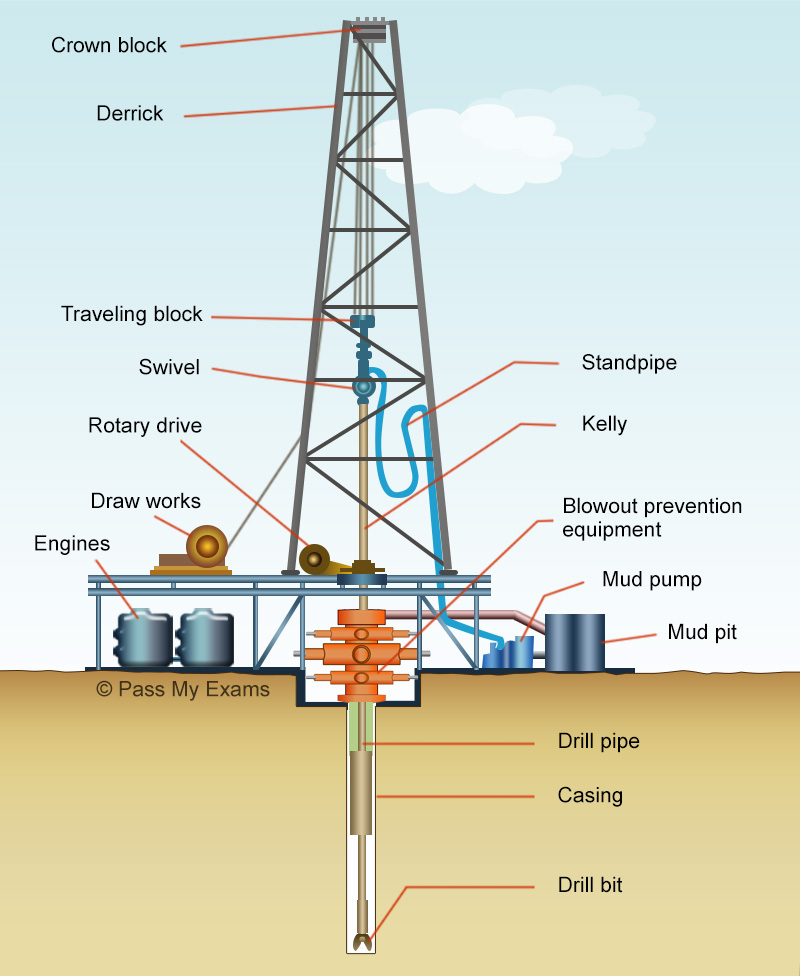Drilling for Crude Oil - The Drilling Rig
Once the field geology and seismic surveying highlights prospects worth investigating, the only way to find out if hydrocarbons are present in commercial quantities is by drilling.
Today, rotary drilling is the method employed. The drill bit is connected to lengths of pipe and mechanically rotated at the bottom of the hole.
In the petroleum industry there are three types of wells:
- Wildcat
- Appraisal
- Development or Production
1. Wildcat Wells
This is the first exploration well in a new prospect and unproven area. The term may have originated from the early 19th Century from the USA where drillers reported wildcats in the vicinity of the wells.
2. Appraisal
These are follow-up exploration wells drilled on structures where wildcats have been successful. They are used to provide a rough outline of the field and evaluate various parameters.
3. Development/Production Wells
Once the field has been appraised and judged economically viable, development wells are drilled to extract hydrocarbons at definite places in the reservoir.
Drilling Rigs
All drilling units tend to be made up of the same components. The differences lie in the rigs themselves which depends on the environment in which they are used.
On land/Onshore
Large rigs are broken down into small loads to aid transport to the drilling location. At the location they can be assembled. Smaller rigs are permanently mounted on a truck or trailer. In inaccessible places such as dense jungles, a heli-rig is used. This is a rig system that can be broken down into small load sizes and airlifted to the location.
At Sea/Offshore
The depth of the sea floor determines the type of rig system to be used offshore.
Submersible Rigs
In locations of shallow waters, submersible rigs are used. These can be floated to the locations and then ballasted (filled with water) to sit on the seabed and provide a stable drilling base.
Jack-up Rigs
In waters of depths of 150m to 300m, jack-up rigs can be used. These are usually towed to the location by tugs and mechanically jack their legs down to the seabed, raising their hulls clear of the water for drilling.
Semi-Submersible Rigs
In deeper waters (up to 2000m) semi-submersible rigs are used. These are big structures supported by columns on hulls or pontoons. The hull or pontoons are ballasted to below the water depth for the drilling mode. These are then anchored to the seabed and also have dynamic positioning systems.
Drill Ships
For deep waters, drill ships are employed. These are ship-shaped vessels with a drilling unit positioned in the middle of the ship through a central hole in the hull.
The Drilling Rig System
The image below shows the basic components of a drilling rig unit.

A drilling rig is made up of five main systems:
- The hoisting system
- The rotary system
- The circulation system
- The power system
- The safety system
The Hoisting System
This consists of the draw works positioned on the rig floor. It has a large winch drum around which the drilling cable or line (a wire rope) is spooled. The drilling line is run over the crown block, an assembly of pulley at the top of the derrick, and down to the travelling block. The draw works raise and lower the drill pipe, casing and tubing.
The Rotary System
The main parts of the rotary system are:
- The rotary swivel which suspends the weight of the drill pipe. It allows for the rotation of the drill pipe beneath it whilst keeping the upper part stationary, so that drilling mud can flow out of the standpipe without leaking.
- The rotary table on the rig floor powered by the rotary drive.
- The Kelly which is a hexagonal or square hollow pipe about 15m long attached to the swivel at the top and connected to the drill pipe at the bottom. The rotary motion of the rotary table is transferred to the drill pipe via the Kelly by the Kelly brushing piece.
The Circulation System
This is the system that pumps the drilling fluids down the well. Drilling fluid or drilling mud is important to the drilling process as they act as a medium to carry the drill cuttings up out of the well hole. The drilling fluid also cools and lubricates the drill bit and pipe, controls pressure and prevents caving of loose formation.
The circulation system consists of the following:
- Mud pumps.
- Storage tanks or pits for the mud.
- The standpipe and kelly in which drilling fluids are transported to the drill.
- The return mud line below the rotary table which returns mud from the well to the shale shaker.
- The shale shaker which removes the drill cuttings before the mud is sent to the mud tanks for cleaning before recirculation.
The Power System
Power is required to impart rotational energy to the drill string. These are either diesel motor engines or direct current electric drives.
The Safety System
The main safety system is called the blowout prevention system. This prevents the uncontrolled escape of oil and gas during drilling. The blowout prevention system consists of a series of hydraulically operated valves and rams. During drilling these are left open to allow drilling muds to circulate. If excessive pressure enters the well the valves can quickly be closed. If excessive pressure from the formation suddenly enters the well, referred to as a kick, pipe rams are closed to prevent overpressure reaching the surface. As the last line of defence in an emergency shear rams are activated which cut through the drill string and seal the well completely.
